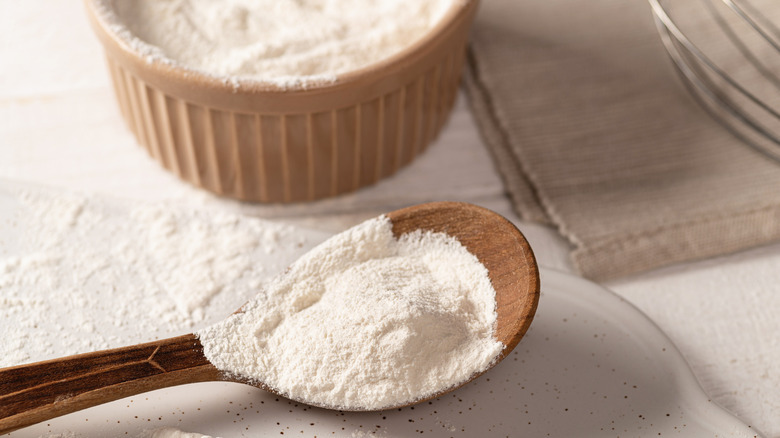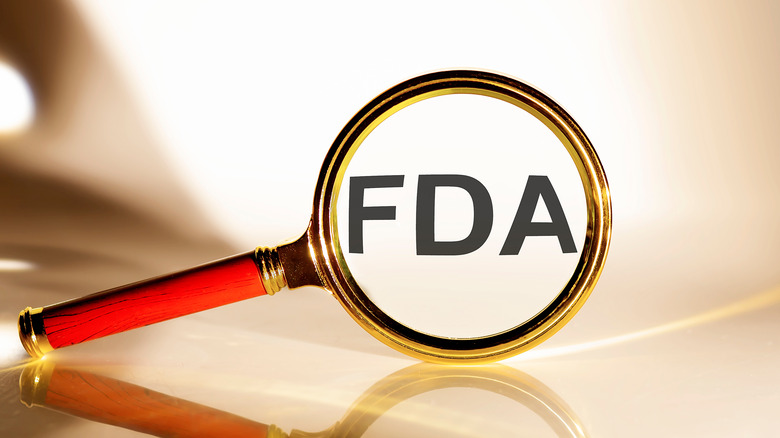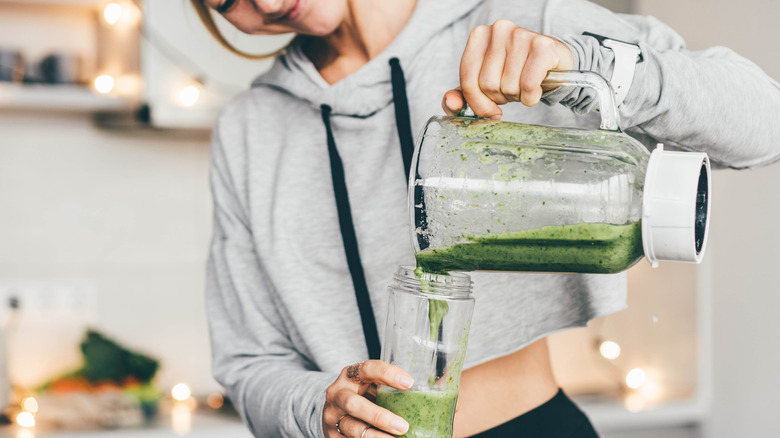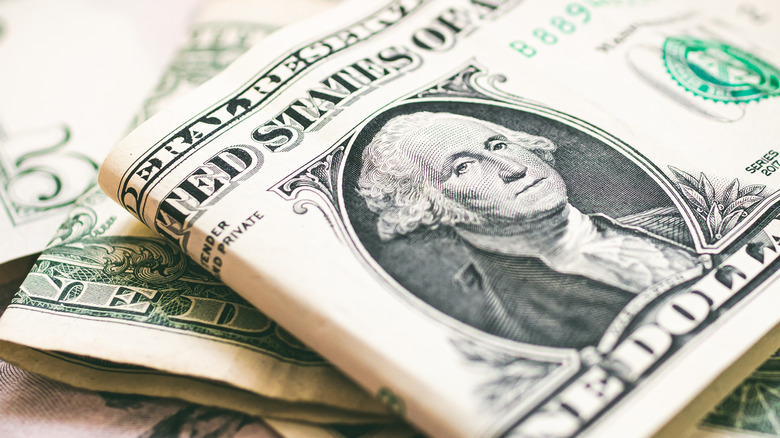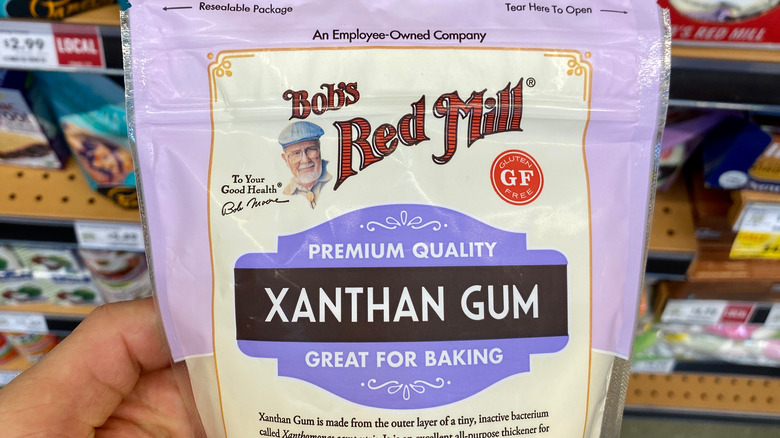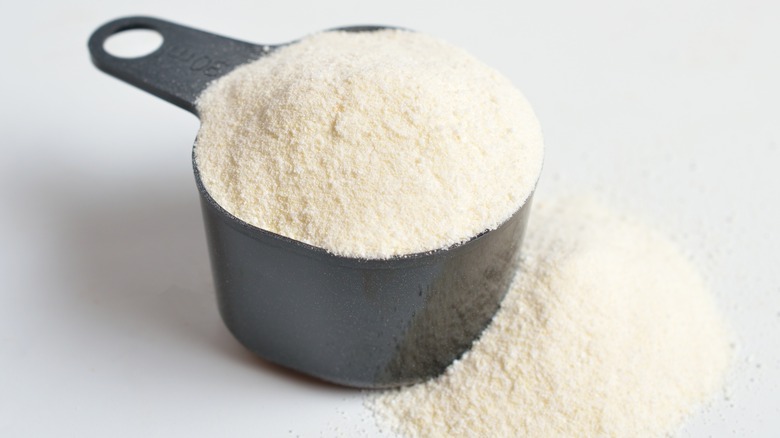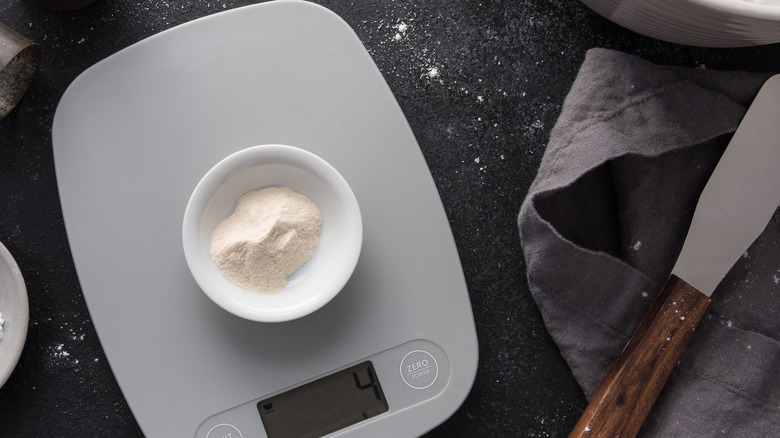9 Facts About Xanthan Gum
We may receive a commission on purchases made from links.
Xanthan gum is one of those ubiquitous ingredients you've likely seen towards the end of many a food label. But have you ever wondered what it actually is? The gum itself, says Science Meets Food, is a flavorless, fermented hydrocolloid — aka water-binding — carbohydrate used to thicken, stabilize, and emulsify foods. It's perfect for thickening liquid-based foods and is fantastic at gelling up. In fact, it's so good at gelling it's used in way more than food. One of the things that is so cool about this gum is that shaking or stirring it actually changes its viscosity. That's why it's often used in pourable foods.
Surprisingly, it's way more natural than it sounds. It's derived from the Xanthomonas campestris bacterium, which, according to Britannica, is a plant pathogen that can cause rot on Brassica plants. It's at this point you may be questioning whether that's even safe to eat. Keep reading to learn the answer to that question, the history of this seemingly-mysterious food additive, and some tips and tricks for using it in the kitchen. Below are nine facts about xanthan gum.
1. It has an interesting history
Xanthan gum has a rather fascinating history. Scientist Allene R. Jeanes discovered it in the 1960s; however, the groundwork for this gum was laid far before that, per Science Meets Food. After thousands of U.S. farms closed during the Great Depression, the United States government decided to invest in researching new ways to use agricultural products. One of those was cornstarch. Studying how cornstarch did (and didn't) convert to sugar and the properties of other polysaccharides and gums led Jeanes to research the X. campestris bacterium and its uses. In 1969, the FDA approved xanthan gum for use as a thickener and stabilizer in foods.
So how is xanthan gum made? X. campestris is first grown on a carbohydrate (usually corn, sugar, whey, or molasses). Then, the actual xanthan gum ferments on the carb. Next, it is pasteurized to deactivate enzymes and filtered. Afterward, all moisture is removed from the xanthan gum before it's milled and packaged for sale.
2. It's safe to eat
With a name like xanthan gum, you may find yourself wondering if it's even safe to eat. No worries there; most people can safely eat it. Moreover, it may even have some health benefits.
Xanthan gum is FDA approved as fit for human consumption. And Healthline points out that it is a soluble fiber that moves straight through your body without being absorbed. That means it's essentially a 0-calorie food. However, that doesn't mean there aren't potential health benefits; though Healthline states these are likely achieved through supplements since the amount of xanthan gum we consume as a food additive is minimal. That said, the gum may lower cholesterol, promote weight loss, and has been used as a saliva substitute.
It should be noted that it is possible to be allergic to xanthan gum. Symptoms include bloating, gas, and diarrhea (via Celiac.com). Additionally, a randomized controlled trial published in Alternative Therapies in Health and Medicine found that somewhere between 4 and 27% of people experience immune reactions to gums, one of those being xanthan. As always, it's essential to listen to your body and work with your doctor if you believe you're experiencing an adverse reaction to xanthan gum.
3. There are so many ways to use it
The xanthan gum mantra is "a little goes a long way." One thing that sets it apart from other gums is that it thickens without being heated. It is incredibly versatile because the viscosity, pH, and temperature of the food you're adding it to don't matter. And because you need such a small quantity — 0.1 to 0.5% by weight — it doesn't impart any funky flavors to your food.
These qualities make xanthan gum a great secret ingredient for perfectly thick smoothies. All you need to do is add a pinch of it to the blender along with your other ingredients. This trick is great to pull out, especially when using protein powders, since it prevents your smoothie from separating after blending. You can also use xanthan gum in gluten-free baking (muffins, pizza crust — you name it!). Xanthan gum replaces the gluten by acting as the "glue" that gluten normally does.
Remember that because it is used in such small quantities, even a small package will last a long time, so you'll need to know how you should be storing xanthan gum. Keep it in an airtight container and away from heat, preferably in a kitchen cupboard or pantry. Storing it in your fridge will just invite moisture and humidity in, causing it to clump. Properly stored, your xanthan gum can last about three years.
4. It's a lot of bang for your buck
There are many reasons that xanthan gum is cost-effective. For one, it has a wide range of applications. According to the Encyclopedia of Food Microbiology (Second Edition), the gum is a great stabilizing, thickening, and emulsifying agent. Moreover, it also improves flavor release in food. Flavor release describes the process of flavor molecules transferring from food to saliva, per "Microencapsulation in the Food Industry" via ScienceDirect. Xanthan gum also enhances the texture, aroma, and appearance of food.
Furthermore, xanthan gum is soluble at various temperatures and works in very small concentrations. That said, if you overdo it, you can add more liquid to thin out your food. The gum's flexibility and versatility make it a cost-effective addition to your pantry. Measure out your gum with a spoon rather than pour it directly from its container. It's more precise and prevents wasted product.
If you do happen to spill some on your counters, it's important to clean it up the right way, or you could be left with an ooey-gooey mess. Bob's Red Mill suggests first dry-wiping or scooping away as much of the dry xanthan gum as you can. Then, apply rubbing alcohol to a clean cloth and wipe down the counter. Next, clean the area with a sponge and dish soap (don't add water!). Wipe the soap away with a dry cloth before washing and rinsing the area with hot, sudsy water.
5. Many recipes use xanthan gum
Xanthan gum is extraordinarily versatile but is probably most commonly used in gluten-free baking, such as this thin and crispy chocolate chip cookie recipe. If it's Sunday brunch you're after, try this gluten-free pancake recipe. Here, the xanthan gum mimics the glueyness that gluten would naturally provide. You don't need much, only a ¼ teaspoon for 12 pancakes, but you will miss it if you skip out.
But gluten-free baking isn't the only type of dietary modification with which xanthan gum can help. If you're vegan or allergic to eggs, xanthan gum can be a great substitute for eggs. You only need to use ¼ teaspoon mixed with ¼ cup of water in place of each egg. Note that this is an excellent substitution in recipes where eggs are used as a binding agent. You should use another egg replacer to add moisture or leavening to your recipe.
Maybe you're not looking for a dietary substitute but rather a restaurant copycat hack. In that case, why not try out Salt & Straw's ice cream base recipe? The chain uses some surprising ingredients, including milk powder and xanthan gum, to achieve its lip-smacking texture.
6. You can buy it at the grocery store
Xanthan gum is widely available in supermarkets and online. While it can seem like a bit of a costly product, Bob's Red Mill points out that the manufacturing process itself isn't cheap, as it's grown in a specialized lab.
You can buy xanthan gum with different certifications, such as gluten-free, keto, vegan, and kosher. If any of those dietary restrictions are important to you, check the labels because not all xanthan gum may fit these requirements. For example, while the gum itself is vegan, not all carbohydrates used to make it are, or in the case of gluten, it might be processed in a facility that uses gluten. According to Vegan Friendly, xanthan gum can be produced from whey, a cheese byproduct. If there are no certifications on the xanthan gum available in your local market, you can always contact the manufacturer.
7. There are alternatives to xanthan gum
If, for some reason, you can't find xanthan gum or if you have an allergy to it, there are alternative options. Some of those options are pectin, guar gum, and carrageenans.
According to NPR, pectin comes from sugar beets and citrus peels. You'll most often find it in jams and jellies. It works well in fillings as well. You can also use it to stabilize drinks that are fruit or milk-based.
Like xanthan gum, guar gum is a polysaccharide, but instead of a bacterium, it comes from beans. It works similarly to xanthan gum, stabilizing and emulsifying liquids like salad dressings. You can also use it in baked goods. Carrageenans come from red seaweeds and are commonly found in commercial dairy products.
If you're in a pinch, psyllium husk, tapioca, or cornstarch are viable substitutes (via Healthline). Since it's also a soluble fiber, psyllium moves through your body similarly to xanthan gum. When using psyllium, use double the amount of xanthan gum your recipe calls for. Cornstarch is an even easier substitute: Just replace it one for one.
8. Xanthan gum isn't just used in foods
Xanthan gum is a powerful multitasker. The Encyclopedia of Food Microbiology (Second Edition) says that it is used in pharmaceuticals, paint, and even toothpaste. Beyond that, you can find it in ceramics, explosives, and the petroleum industry. According to a study published in Cellular and Molecular Biology, one of the reasons xanthan gum is used in pharmaceuticals is that it helps make delayed-release medicines delayed release. In the oil industry, it's used as a thickener added to drilling fluid, per All The Science.
You can even do fun science experiments at home with your kids (or by yourself, no judgment). Science Fun says you can make "Bubbling Slime" with vinegar, food coloring, baking soda, and xanthan gum. First, place 2 cups of white vinegar into a bowl and stir in 1-¼ teaspoons of xanthan gum. After that, stir in your food coloring. Refrigerate the mixture for a couple of hours so any clumps left in the vinegar absorb. You'll know it's ready once it appears creamy but gooey and still runs off of a whisk. Now, take a plastic storage container that you've coated with baking soda. When you pour your slime over the container, it should bubble up.
With all these uses, if you are anything like us, you're probably wondering if you can make xanthan gum at home. Unfortunately, according to Grocery Shrink, the answer seems to be no. Luckily, it's widely available.
9. It's in (nearly) everything
Why is xanthan gum in (practically) everything? Without it, so many liquid-based foods would stay that way — too watery. They wouldn't bind and your gluten-free baked goods would fall apart. Without it, your salad dressing wouldn't glide smoothly out of the bottle. Xanthan and other gums are also used as fat replacers. Per the Encyclopedia of Food Sciences and Nutrition (Second Edition), gums are often commercially used to replace fats in low-calorie foods. It's also a way to increase the fiber content in foods. Really, you eat xanthan gum every day, and you don't even know it.
Not only has the FDA approved xanthan gum as a food ingredient, but according to the International Food Additives Council, the World Health Organization has also approved it, including Canada, China, and the EU. Using gums or additives is nothing new. It's important to remember that we've been putting so-called chemicals in our food for a long time. According to the Science Museum, there were chemical methods of food preservation in ancient China, Egypt, and Rome. In the United States, the FDA has been regulating food additives since 1958 (via USDA).
